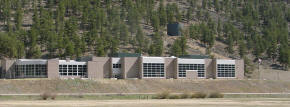Mr. Ghist's Science Page
Platte Canyon High
School
Bailey, Colorado

SCIENCE
STANDARDS
2
|
Mr. Ghist's Science Page |
Platte Canyon High
School |
|
 |
SCIENCE
STANDARDS |
|
| ================================================== | ||
Students know and understand common properties, forms, and changes in matter and energy
|
BENCHMARKS 2.1 Students
know that matter has characteristic properties, which are related to its
composition and structure
2.2 Students
know that energy appears in different forms, and can move (be transferred)
and change (be transformed).
2.3 Students
understand that interactions can produce changes in a system, although the
total quantities of matter and energy remain unchanged.
|
| GRADE LEVEL
EXPECTATIONS
Guiding
questions: ·
How
do we describe the physical world around us? ·
What
is the world around us made of and how do we know? ·
What
is energy? ·
How
do electricity, magnetism, sound, and light interact with matter? Expectations: demonstrate
how the Periodic Table can be used to predict the properties of elements
and reflects trends in these properties as they relate to the physical
world describe
the molecular, atomic, and ionic makeup of a variety of substances, use
appropriate formula to represent these substances and investigate common
chemical reactions use
bonding diagrams (ionic, covalent) to predict the outcome of a chemical
reaction use
word or symbol equations to predict chemical and physical interactions
(neutralization, combustion, Newton's Second Law) analyze
and discuss the effect of solute and solvent concentration on the rate of
dissolving, acidity, and viscosity of a solution describe
the components of the modern model of the atom and how they are related design
an electrical circuit and apply Ohm's Law to evaluate the components of
the circuit (voltage and
resistance affect the flow of electrical current in a circuit) explain
the Doppler effect and identify some of its applications (energy can be
transferred as waves; the frequency and wavelengths of the waves are
affected by the relative motion of the source and receiver) describe
how energy is involved in chemical, physical and nuclear changes investigate
the relationship between heat and work (e.g. how the interior of a
refrigerator is cooled) investigate
phase changes that are induced by adding/subtracting heat energy and
explain using the particle model, how the interaction of atoms or
molecules during a change of state affects the properties of the substance give
an example of an object moving in a circular path and find and compare its
speed, period, frequency, acceleration and centripetal force with other
masses and report these findings collect
and graph data and explain that acceleration is a change in velocity or
direction of travel calculate
and report the acceleration and motion of several different objects when
released from the same position observe,
interpret, and explain the behavior of a compass needle near a permanent
magnet formulate
a model of radioactive decay demonstrate
that for every action there is an equal and opposite reaction (e.g.
identifying places on a roller coaster ride where one feels lighter or
heavier) observe,
diagram, and label the parts of transverse waves having different
frequencies and amplitudes use
a wave model of light to predict optical phenomena observe
and measure the effect of friction on moving objects know that the laws of conservation of energy and momentum provide a way to predict and describe the movement of objects |
| ================================================= |